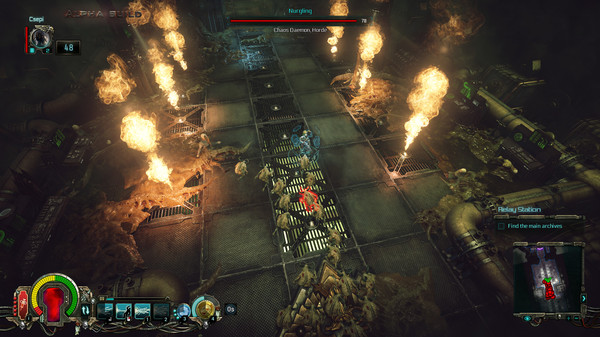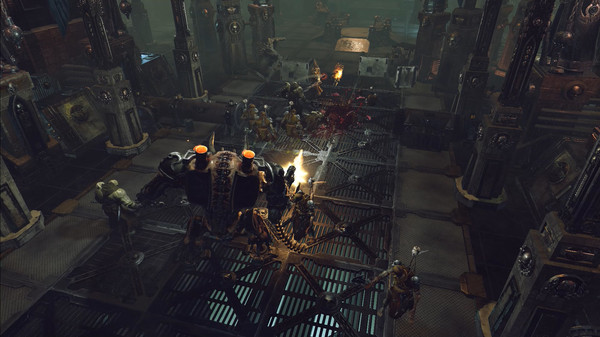Warhammer 40000 Inquisitor – Martyr (bundled with Prophecies in the definitive edition, which I would highly recommend) is a hack and slash game. The game is set in the Warhammer 40K universe, and does it justice, both in visuals, and in general tone. There is an offline version of the game, I chose that right from the start. In the online part you can play together with others, there are guilds and season characters – all of which I ignored in my offline play. Season characters get unique rewards, I missed out on those. Since the online and offline versions are hermetically sealed, you should decide right from the start which you want to play. The advantage of the offline is that you won’t lose the loot from the last run, or in extreme case your whole progress if there is an issue with connecting to the servers. The gameplay will be clearing maps of enemies, of which there will be quite a varied selection. The scripted stories from the base game and DLCs took me around 50 hours to finish the first time. The base campaign (i.e. the first five chapters) was almost 30 hours. Various mechanisms are unlocked through the campaign, so you should play it till chapter 4 even if not interested in the story. The vendor and storage for example will appear only after finishing the relatively short Chapter1 (i.e. tutorial). There are several classes to choose from, but for the first play don’t choose a tech priest. That will have a different tutorial scenario, happening in parallel towards the end of the base campaign. Then it will continue with Chapter 6 of the main storyline, skipping all the previous parts. In fact, the tech priest can be played through the standalone prophecies extension too (it is a separate entry in the gamelist), but you should play it in the main game instead. I played through the base campaign with a crusader, but the tutorial Chapter 1 can be quickly played with all the possible classes, and then you can choose your favorite. There are two map types : corridor based and open field. Most of the maps will be corridor based. There will be some variety of the goals on the map, but in the end it is mostly just how many enemies you can ignore completing the goal. Killing everything is always an option, and sometimes the required task. A special case is when you must protect someone. There are only a few such campaign occasions, but then if the person dies, the map is failed. Otherwise, dying on a campaign map has no consequence, you just respawn nearby, keeping the progress and loot. In fact in the final map I just kept doing suicide runs on the final boss, eventually killing it (and unlocking a perk because of the number of times I died on maps as a crusader). There is a large skill tree. Some entries are class specific, but most of them are shared between characters. At first most shared entries will be disabled, but by playing the game eventually they will be unlocked through fulfilling the requirements for them. Generally you should focus on the class based skills first. Soon enough the cost of total respecing will be trivial enough. The same is not true though for your gear, that is much harder to re-orient for a completely different build. Early on you will be selling your loot, as the only option to get rid of the junk, or even relics, but by Chapter 3 you will unlock the ability to break them down for materials, which I did after that point. There are always some high value drops, like intelligence, which can be sold to vendors, those will be enough source of money, besides what you gather directly on the maps. A small storage is shared by all characters. The music of the game is good, though it mostly melds into the background during the missions. The sound effects are very satisfying, the sound of weapons and attacks are fitting, and the enemies die with satisfying sound (and visual) feedback. Your character is fully voice acted, and so are the members of your crew, and a few quest givers. The voice actors generally do a great job. The graphics of the game are good enough. With all the DLC’s there will be a lot of enemy variations (though there will be only 1-2 factions on a given mission map), with varied animations – and ways of fight. The backgrounds are reasonably detailed too. There is no save system, aside from autosave after the end of a map. Generally the maps don’t take much time, some are shorter than 10 minutes. The game can be played with keyboard and mouse, or with a controller. The game won’t switch seamlessly between K&M and controller, you have to do it in the options menu, and perhaps restart the game. Not that it mattered, I played with K&M, the game seems to be with that in mind. There are a few game modes, prolonging the lifetime of the game after finishing all the main and DLC campaigns. Probably the oldest one is a warzone, a set of predetermined missions starting from level 50 and progressing till level 100. Another option are the randomly generated missions, out of the few archetype missions. There are a few priority missions, as purchasable DLCs. They have a meager written background story, and you can make a few decisions during them. In the end, one priority mission storyline can be completed in around an hour, and some will reward you with cosmetic rewards the first time you complete them. By far the most interesting option is however the void crusades. These are journeys through some predetermined graphs with nodes and available paths. They have a start point and several end points. By traveling through the available paths, you reach nodes. You can see only the effect of the immediately available nodes, though the setup and end nodes location will be clearly visible. The catch is that some nodes will permanently increase the difficulty. Most with only +1, but some by +2. But you must progress through some of them to reach the exit. For example, having a +4 difficulty will increase the received damage by around 200%, and reduces the dealt damage by around 80%. The more nodes you travel through, the higher end rewards there will be – if you ever reach a final exit. Still, merely completing a node will reward you with some random rewards too, so even failing to reach the end isn’t a total failure. Some maps have keys hidden in them, collecting those will allow to open more from the final reward chests. All in all it is a nice risk versus reward adventure, and probably the end game content for most offline players. There is a card system, to increase difficulty – and to receive specific rewards along. Things like more XP, or more chance for relics. The effect of the cards can be upgraded, but for that you must collect a specific currency. Not sure how to obtain it, but eventually I collected a few. Not that it matters, as they can be used only to increase one random card by 1 fraction. There are around 40 cards, each with 10 fractions, so even after close to 100h I wasn’t in the situation to upgrade even a single card. Supposedly each card can be upgraded multiple times. While I bought the definitive edition, one DLC was still unavailable – the hierophant. Granted, I didn’t even finish the story with the all the base classes. My tech priest was level 75, my crusader 51, my battle sister 37, the rest of the classes 7. The hierophant seems similar to the tech priest, but using other human characters instead of constructs. There are 3 weekly mission opportunities. Those increase the standing with the 3 ordos factions, unlocking various permanent bonuses. Those weekly missions reset on Sunday, but due to a bug I could only play them after Tuesday, leaving a total of around 5 days instead a full weak. Not that it matters, a mission takes around 15 minutes or less. The offline game was stable, it didn’t crash for me – though the online version might act differently if the mandatory connection to the servers fails.
Expand the review




























